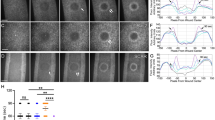Abstract
Myocardial infarction results in the formation of granulation tissue in the injured ventricular wall. This tissue contains myofibroblasts in highly organized arrays; their contractile properties may help to prevent the infarct area from dilatation. The mechanisms that control myofibroblast alignment are unknown. We found that myofibroblasts express a homologue of Drosophila tissue polarity gene frizzled (fz2) when migrating into the granulation tissue. The expression is decreased after the cells have aligned. This suggests that fz2 is involved in the spatial control of cardiac wound repair after infarction, possibly through intra- and inter-cellular transmission of polarity signals as in developing Drosophila. Mutations in the fz2 gene may impair myofibroblast alignment in the infarct area, thereby resulting in ventricular dilatation and aneurism following infarction.
This is a preview of subscription content, access via your institution
Access options
Subscribe to this journal
Receive 12 print issues and online access
$209.00 per year
only $17.42 per issue
Buy this article
- Purchase on Springer Link
- Instant access to full article PDF
Prices may be subject to local taxes which are calculated during checkout
Similar content being viewed by others
References
Willems, I.E.M.G. et al. The a-smooth muscle actin-positive cells in healing human myocardial scars. Am. J Pathol. 145, 868–875 (1994).
Sun, Y. et al. Cardiac angiotensin converting enzyme and myocardial fibrosis in the rat. Cardiovasc Res. 28, 1423–1432 (1994).
Cleutjens, J.P.M. et al. Collagen remodeling after myocardial infarction in the rat heart. Am J Pathol. 147, 325–338 (1995).
Vracko, R. & Thorning, D. Contractile cells in rat myocardial scar tissue. Lab Invest. 65, 214–227 (1991).
Schmitt-Graf, A., Desmouliere, A. & Gabbiani, G. Heterogeneity of myofibroblast phenotypic features: An example of fibroblastic cell plasticity. Virchows Arch. 425, 3–24 (1994).
Gaudron, P. et al. Progressive left ventricular dysfunction and remodeling after myocardial infarction. Circulations 87, 755–763 (1993).
Blankesteijn, W.M. et al. Increased expression of a homologue of Drosophila tissue polarity gene ‘frizzled’ in left ventricular hypertrophy in the rat, as determined by subtractive hybridization. J Mol Cell Cardiol. 28, 1187–1191 (1996).
Adler, P.N. The genetic control of tissue polarity in Drosophila. BioEssays 14, 735–741 (1992).
Gubb, D. Genes controlling cellular polarity in Drosophila. Development 1993 Suppl., 269–277 (1993).
Chan, S.D.H. et al. Two homologs of the Drosophila polarity gene frizzled (fz) are widely expressed in mammalian tissues. J Biol Chem. 267, 25202–25207 (1992).
Zhao, Z. et al. A human homologue of the Drosophila polarity gene frizzled has been identified and mapped to 17q21.1. Genomics 27, 370–373 (1995).
Willems, I.E.M.G. et al. Structural alterations in heart valves during left ventricular pressure overload in the rat. Lab Invest. 71, 127–133 (1994).
Wang, Y. et al. A large family of putative transmembrane receptors homologous to the product of the Drosophila tissue polarity gene frizzled. J Biol Chem. 271, 4468–4476 (1996).
Bodmer, R. Heart development in Drosophila and its relationship to vertebrates. Trends Cardiovasc Med. 5, 21–28 (1995).
Wong, L.L. & Adler, P.N. Tissue polarity genes of Drosophila regulate the subcellular location for prehair initiation in pupal wing cells. J Cell Biol. 123, 209–221 (1993).
Eyden, B.P. Brief review of the fibronexus and its significance for myofibroblastic differentiation and tumor diagnosis. Ultrastruct Pathol. 17, 611–622 (1993).
Bhanot, P. et al. A new member of the frizzled family from Drosophila functions as a Wingless receptor. Nature 382, 225–230 (1996).
Krasnow, R.E., Wong, L.L. & Adler, P.N. Dishevelled is a component of the frizzled signaling pathway in Drosophila. Development 121, 4095–4102 (1995).
Pizzuti, A. et al. Human homologue sequences to the Drosophila dishevelled segment-polarity gene are deleted in the DiGeorge syndrome. Am. J. Hum. Genet. 58, 722–729 (1996).
Mierop, L.H.S. & Kutsche, L.M. Cardiovascular anomalies in DiGeorge syndrome and importance of neural crest as a possible pathogenetic factor. Am J Cardiol. 58, 133–137 (1986).
Passier, R.C.J.J. et al. Activation of angiotensin-converting-enzyme in the infarct zone following myocardial infarction. Am J Physiol. 269, H1268–H1276 (1995).
Dijkstra, C.D. et al. The heterogeneity of mononuclear phagocytes in lymphoid organs: Distinct macrophage subpopulations in the rat recognized by monoclonal antibodies ED1, ED2 and ED3. Immunology 54, 589–599 (1985).
Author information
Authors and Affiliations
Rights and permissions
About this article
Cite this article
Blankesteijn, W., Essers-Janssen, Y., Verluyten, M. et al. A homologue of Drosophila tissue polarity gene frizzled is expressed in migrating myofibroblasts in the infarcted rat heart. Nat Med 3, 541–544 (1997). https://doi.org/10.1038/nm0597-541
Received:
Accepted:
Issue Date:
DOI: https://doi.org/10.1038/nm0597-541
This article is cited by
-
Exendin-4 Attenuates Remodeling in the Remote Myocardium of Rats After an Acute Myocardial Infarction by Activating β-Arrestin-2, Protein Phosphatase 2A, and Glycogen Synthase Kinase-3 and Inhibiting β-Catenin
Cardiovascular Drugs and Therapy (2021)
-
Multipoint targeting of TGF-β/Wnt transactivation circuit with microRNA 384-5p for cardiac fibrosis
Cell Death & Differentiation (2019)
-
Wnt signaling cascade in restenosis: a potential therapeutic target of public health relevance in a North American cohort of Nebraska State
Molecular Biology Reports (2014)
-
Targeting Wnt-Frizzled signaling in cardiovascular diseases
Molecular Biology Reports (2013)
-
Interventions in Wnt signaling as a novel therapeutic approach to improve myocardial infarct healing
Fibrogenesis & Tissue Repair (2012)



